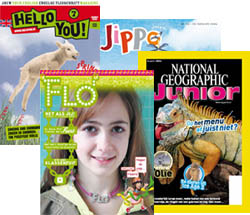The idea behind edutainment is to synthesize learning and fun – to provide products that are both educational and entertaining. Books, magazines and CD ROMs with a pedagogic twist enable children to continue learning after school. Exploring the consumer market further is one of the strategic aims of SanomaWSOY Education. While edutainment has barely lifted off the ground in Belgium and in Finland, the Netherlands has an established consumer market tailored to children and youth in K-12 education. Fun Learning Malmberg entered the edutainment business with the launch of two magazines nearly 90 years ago, and the company's current portfolio ranges from eight magazines to some 25–30 books and 15 cd-roms a year. | |
What is unique about the Dutch edutainment system is that while parents rather than the school are the customers, schools are the main marketing channel.
Schools act as an important link between parents and us, hence the term via-school-to-home market. It is in part because of the schools that we are able to keep the cost of products down to the extent as to ensure that they are within the reach of all parents. This is very important to us, reflects Malmberg's Business Unit Manager Martijn Kole.
The popularity of edutainment is linked heavily to the obvious advantages of continued learning. Children are encouraged to explore things in a less formal way, and during the process they also learn to learn. Potential customers are aged anywhere between 2 and 18, though emphasis is laid on 4 to 12 year olds in primary education, and products take into account the needs of particular age and interest groups.
– Younger children want to know everything, and they want to challenge their parents with what they know. Older children, on the other hand, are more interested in social development, Kole unfolds.
Parents want the best for their children. They are encouraged when they notice that their children have fun with pedagogic material, and they are obviously pleased about the positive effect edutainment has on school results.
While Malmberg is not without competition in the consumer market, it is nevertheless in a strong position because of its long history of expertise and experience.
International group spirit
In 2005, an enthusiastic business team was established to discuss how to build on and expand the role of edutainment from Malmberg's Dutch success story to SanomaWSOY Education's international one.
The team was set to determine how it may be possible to benefit from group wide expertise and experience. Workshops have lifted international aspirations and already under way, or in the past even, are a pilot in Finland, a project renewal in Belgium and a portfolio extension in the Netherlands.
Case Finland
WSOY Oppimateriaalit undergone a pilot which was a direct mail advertising campaign targeted at 32,000 parents of first-formers. Products on offer were reading packages for children learning to read. An interesting feature of the campaign was that 2% of the orders were received by SMS, and more is on its way already: Following last year's pilot, the next step for WSOY Oppimateriaalit was a series of four holiday readings released in May.
– We are looking for growth opportunity in the consumer market, and providing something for children who often spend much of the early summer and term-time afternoons without parental supervision seems like a natural progression. Later we are interested in expanding the business even further, Publishing Manager Juha-Pekka Heinonen sights.
The holiday readings have been produced by renowned educational authors, which gives them a solid pedagogic grounding
While edutainment in the consumer market appears attractive, Heinonen admits that the field is demanding. Those entering the field need to be cautious not to misuse the market, and moreover, to ensure that any products are carefully planned out.
Text: Tuuli Kousa Pictures: Malmberg